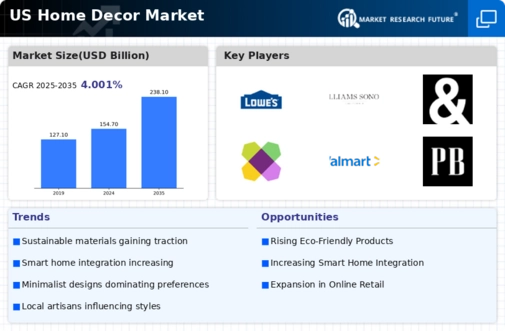Rising Disposable Income
The home decor market in the US is experiencing a notable increase in consumer spending, driven by rising disposable incomes. As households enjoy higher earnings, they are more inclined to invest in home improvement and decor. This trend is particularly evident among millennials and Gen Z, who prioritize aesthetics and comfort in their living spaces. According to recent data, the average household income has risen by approximately 5% annually, leading to a surge in demand for premium home decor products. This increase in disposable income allows consumers to explore a wider range of options, from luxury furnishings to artisanal decor items, thereby stimulating growth in the home decor market.
Influence of Social Media
The home decor market in the US is increasingly shaped by the influence of social media platforms. Consumers are exposed to a plethora of design ideas and trends through platforms like Instagram and Pinterest, which serve as significant sources of inspiration. This visual-centric approach encourages individuals to invest in home decor that reflects their personal style. Recent studies indicate that approximately 70% of consumers report that social media influences their purchasing decisions in home decor. As a result, brands are leveraging social media marketing strategies to engage with potential customers, thereby enhancing their visibility and driving sales in the home decor market.
Focus on Health and Well-being
The growing awareness of health and well-being is emerging as a crucial driver for the home decor market in the US. Consumers are increasingly seeking decor solutions that promote a healthy living environment, such as air-purifying plants, non-toxic materials, and ergonomic furniture. This trend aligns with a broader societal shift towards wellness, where individuals prioritize their physical and mental health. Market Research Future suggests that products emphasizing health benefits are witnessing a growth rate of around 8% annually. Consequently, manufacturers and retailers are adapting their offerings to meet this demand, thereby contributing to the expansion of the home decor market.
Urbanization and Housing Trends
The ongoing trend of urbanization significantly impacts the home decor market in the US. As more individuals migrate to urban areas, the demand for stylish and functional home decor solutions rises. Urban dwellers often seek to maximize limited space, leading to a preference for multifunctional furniture and innovative storage solutions. Additionally, the housing market has shown a steady increase in new home constructions, with a reported growth of 3% in housing starts over the past year. This surge in new homes creates opportunities for home decor retailers to cater to fresh buyers looking to personalize their spaces, thus driving growth in the home decor market.
E-commerce Growth and Online Shopping
The home decor market in the US is significantly benefiting from the rapid growth of e-commerce and online shopping. With the convenience of purchasing home decor items from the comfort of one's home, consumers are increasingly turning to online platforms for their decor needs. Recent data indicates that online sales in the home decor sector have surged by approximately 15% over the past year. This shift towards digital shopping is prompting traditional retailers to enhance their online presence and improve customer experience through user-friendly websites and virtual showrooms. As a result, the home decor market is likely to continue evolving, driven by the increasing preference for online shopping.

























Leave a Comment